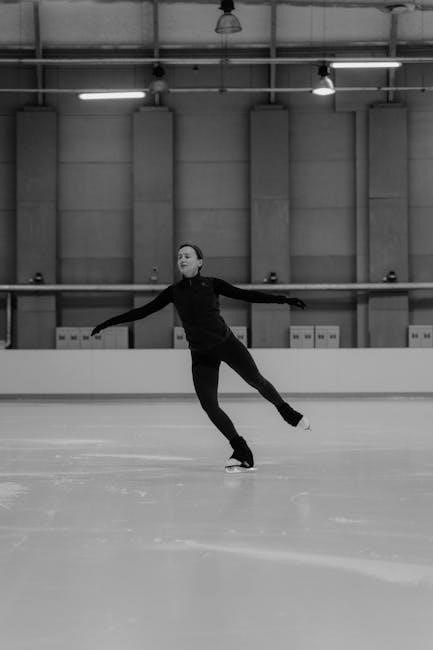Synchronicity, a concept introduced by Carl Jung, refers to meaningful coincidences that lack a causal connection, exploring the intersection of psyche and reality. It offers insights into human experience and consciousness, with resources like The Structure and Dynamics of the Psyche providing deeper understanding.

1.1 Definition and Core Principles
Synchronicity, as defined by Carl Jung, refers to the occurrence of two or more events that seem to be meaningfully connected, yet lack a causal relationship. This concept suggests that such coincidences are not merely random but carry psychological significance. Jung introduced synchronicity as an acausal connecting principle, bridging the gap between the inner world of the psyche and the outer world of events. It emphasizes the idea that certain events are symbolically linked, offering insights into the collective unconscious. The core principle lies in its ability to reveal deeper patterns and meanings, often facilitating personal growth and self-discovery. Jung’s work, as detailed in The Structure and Dynamics of the Psyche, explores this phenomenon, highlighting its relevance to understanding human consciousness and experience.
1.2 Historical Background and Development
Carl Jung introduced the concept of synchronicity in the mid-20th century, evolving from his work in analytical psychology. The term gained prominence in his 1952 paper, Synchronicity: An Acausal Connecting Principle, where he explored meaningful coincidences beyond causality. Jung’s ideas were influenced by his collaborations with physicist Wolfgang Pauli, blending psychology with theoretical physics. His personal experiences, such as the famous scarab beetle incident, further shaped his understanding. The concept emerged during Jung’s departure from Freudian psychoanalysis, marking a significant shift in his theoretical framework. Over time, synchronicity has been integrated with quantum physics and chaos theory, expanding its applications. Despite debates on its empirical validation, Jung’s synchronicity remains a cornerstone of depth psychology, offering insights into the interconnectedness of psyche and reality.
Key Concepts in Synchronicity
Synchronicity involves meaningful coincidences tied to the collective unconscious and archetypes, central to Jung’s theory, linking personal and universal experiences beyond causality.
2.1 The Collective Unconscious
The collective unconscious, a concept introduced by Carl Jung, refers to a shared reservoir of archetypes present in the unconscious mind of all humans. These archetypes, such as the Mother, Trickster, or Hero, are universal symbols and images that appear across cultures and time. Jung proposed that the collective unconscious is inherited, not learned, and forms the foundation of human thought and experience. It is this shared psychological layer that enables synchronicity, as meaningful coincidences often involve archetypes that resonate universally. The collective unconscious bridges the personal and the universal, providing a framework for understanding how synchronistic events can have profound personal and cultural significance. This concept remains central to Jung’s theory of synchronicity, linking individual experiences to broader psychological and symbolic patterns.
2.2 Archetypes and Their Role
Archetypes, as defined by Carl Jung, are universal symbols and images that recur across cultures and time, residing in the collective unconscious. These innate patterns shape human behavior, thoughts, and experiences, influencing how individuals perceive the world and themselves. Examples include the Mother, Trickster, and Hero archetypes. Archetypes play a crucial role in synchronicity by facilitating meaningful coincidences that lack a causal connection. They provide a common ground for such events, as their universality allows symbols and experiences to resonate deeply. For instance, transformative life events may align with Hero archetype symbols, creating synchronistic moments. Understanding archetypes enhances the ability to recognize and interpret synchronicities, leading to deeper personal insights and psychological growth. Archetypes thus serve as a bridge between the collective unconscious and individual experiences, enriching the understanding of synchronicity.
Case Studies and Examples

Jung’s work highlights the scarab beetle incident, where a patient’s dream of a scarab coincided with a real beetle appearing, illustrating synchronicity. Such cases demonstrate meaningful coincidences beyond causality, often aligning with archetypal themes. These examples, documented in The Structure and Dynamics of the Psyche, reveal how synchronicity bridges the psyche and reality, offering profound insights into human experience and consciousness.
3.1 Jung’s Personal Experiences
Carl Jung’s personal experiences deeply shaped his concept of synchronicity. One of the most famous examples is the scarab beetle incident, where a patient’s dream of a golden scarab coincided with a real scarab beetle tapping on Jung’s office window. This event, documented in The Structure and Dynamics of the Psyche, profoundly influenced his belief in meaningful coincidences. Jung also reflected on his own life, noting how synchronicity guided his intellectual journey, particularly during his break from Sigmund Freud. These experiences led him to explore the connection between the collective unconscious and external events, forming the cornerstone of his synchronicity theory. His personal insights remain a vital part of understanding this phenomenon.
3.2 The Scarab Beetle Incident
The scarab beetle incident is one of Carl Jung’s most compelling examples of synchronicity. During a therapy session, a patient recounted a dream about a golden scarab beetle, a symbol of transformation. Moments later, a real scarab beetle tapped on Jung’s office window. This striking coincidence occurred at a critical juncture in the patient’s therapy, illustrating the concept of meaningful connection between inner and outer worlds. Jung documented this event in his works, such as The Structure and Dynamics of the Psyche, highlighting its significance in understanding synchronicity. The incident underscored the idea that such events transcend causality, reflecting deeper psychological and universal patterns. This anecdote remains a cornerstone in discussions of Jung’s theory, offering a vivid illustration of synchronicity in action.

Synchronicity and Modern Science
Jung’s synchronicity bridges psychology and science, linking it to quantum physics and chaos theory, offering new insights into non-causal events and interconnectedness, as explored in his works.
4.1 Connection to Quantum Physics
Carl Jung’s concept of synchronicity has intriguing parallels with quantum physics, particularly in phenomena like entanglement and non-locality. Just as particles can instantaneously influence each other regardless of distance, synchronicity suggests a similar interconnectedness in human experiences. This alignment implies that meaningful coincidences might not be random but part of a deeper, unified reality. The collaboration between Jung and physicist Wolfgang Pauli further explores this intersection, blending psychological and physical principles. Such connections hint at a broader framework where consciousness and matter are not entirely separate entities. This interplay challenges traditional views of causality and opens new avenues for understanding the nature of reality and human perception. The fusion of Jungian thought with quantum theory continues to inspire interdisciplinary research and philosophical debate.
4.2 Chaos Theory and Its Implications
Chaos theory, which studies complex and dynamic systems, offers intriguing insights into synchronicity. The “butterfly effect,” where small events trigger large outcomes, parallels the idea of meaningful coincidences shaping human experiences. Jung’s concept aligns with chaos theory’s emphasis on interconnectedness and non-linear relationships. Both suggest that seemingly random events may hide deeper patterns. This perspective provides a scientific framework for understanding synchronicity, moving beyond mere chance. The interplay between chaos theory and synchronicity invites a reevaluation of how we perceive causality and the nature of reality. By exploring these connections, researchers can uncover new ways to interpret meaningful coincidences and their role in shaping human consciousness and experiences. This interdisciplinary approach enriches our understanding of complexity and its implications for modern thought.
Applications in Personal Growth
Synchronicity aids in self-discovery by revealing hidden patterns and connections, empowering individuals to align with their true path and embrace meaningful life transformations through heightened awareness.
5.1 Recognizing Synchronicity in Life
Recognizing synchronicity involves paying attention to recurring patterns and meaningful coincidences that feel symbolic or guiding. It requires a blend of self-awareness and openness to the idea that certain events may carry deeper significance beyond mere chance. Jung emphasized that these moments often reflect connections between the conscious and unconscious mind, offering insights into personal growth and life’s purpose. By journaling such experiences and reflecting on their personal significance, individuals can better identify synchronicity in their lives, fostering a greater sense of alignment with their inner selves and the world around them. This practice encourages a mindful and curious approach to daily experiences.

5.2 Using It for Self-Discovery

Using synchronicity for self-discovery involves interpreting meaningful coincidences as reflections of the unconscious mind. Jung believed these events guide individuals toward their true selves, helping them uncover hidden fears, desires, and potential. By examining recurring symbols or themes in these moments, one can gain clarity on personal goals and unresolved issues. This process fosters emotional healing and integration of the psyche, leading to a more whole and balanced individual. Synchronicity serves as a tool for self-reflection, encouraging deeper understanding and alignment with one’s life purpose. Embracing this concept can empower individuals to embrace their authentic selves and navigate life’s challenges with greater insight and purpose.

Synchronicity in Therapy
Carl Jung’s synchronicity, involving meaningful coincidences, is a therapeutic tool that explores the unconscious, aiding self-discovery and fostering emotional healing in clients.

6.1 Role in Analytical Psychology
In analytical psychology, synchronicity serves as a bridge between the conscious and unconscious mind, revealing hidden patterns and meanings in therapeutic settings. Carl Jung emphasized its role in facilitating deeper self-awareness and emotional healing. By recognizing meaningful coincidences, therapists can guide clients to uncover repressed thoughts and desires, fostering a more integrated sense of self. Synchronicity also highlights the interconnectedness of psychological and physical events, offering a holistic approach to understanding human behavior. This concept remains central to Jungian therapy, providing a unique lens through which to explore the complexities of the psyche and promote personal transformation and growth.
6.2 Enhancing Therapeutic Outcomes
Synchronicity significantly enhances therapeutic outcomes by revealing meaningful connections between a client’s experiences and their inner world. Carl Jung believed that these coincidences could deepen the therapeutic alliance, fostering trust and engagement. By exploring synchronistic events, therapists can uncover unconscious patterns, accelerating the healing process. This approach also empowers clients to recognize their own resilience and capacity for transformation. Synchronicity bridges the rational and emotional, promoting a holistic understanding of psychological distress. Its integration into therapy offers a powerful tool for addressing complex issues, ultimately leading to more profound and lasting positive change in individuals’ lives.

Cultural and Philosophical Implications
Synchronicity bridges analytical psychology with spirituality, offering a profound understanding of interconnectedness. It influences modern thought and integrates seamlessly with various philosophical traditions, enriching cultural perspectives globally.
7.1 Influence on Modern Thought
Carl Jung’s concept of synchronicity has profoundly influenced modern thought, reshaping perspectives on consciousness and reality. It has inspired interdisciplinary discussions, integrating psychology, physics, and spirituality. The idea that meaningful coincidences reveal deeper connections in the universe has sparked debates in philosophy, science, and culture. Jung’s work encourages a holistic understanding of human experience, fostering a bridge between scientific inquiry and spiritual exploration. By challenging traditional notions of causality, synchronicity has become a cornerstone in contemporary discussions about the nature of reality and human consciousness, offering new avenues for self-discovery and intellectual exploration across various fields.
7.2 Integration with Spiritual Practices
Jung’s synchronicity has deeply resonated with spiritual practices, offering a framework to understand meaningful coincidences as guidance from the universe. It aligns with concepts like divine intervention or karma, where events are seen as purposeful. Many spiritual traditions embrace synchronicity as a tool for self-reflection and alignment with one’s higher purpose. Practices such as meditation and journaling are often recommended to enhance awareness of these meaningful coincidences. By integrating synchronicity into spiritual routines, individuals can foster a deeper connection to their inner selves and the world around them, leading to a more fulfilling and purpose-driven life. This blend of psychology and spirituality continues to inspire personal growth and transformation globally.

Resources and Further Reading
Explore Carl Jung’s works like The Structure and Dynamics of the Psyche for deeper insights into synchronicity. Furlotti’s explanations and online courses offer practical understanding and applications.
8.1 Recommended PDFs and Literature
For a deeper understanding of Carl Jung’s concept of synchronicity, several key PDFs and literary works are essential. Synchronicity: An Acausal Connecting Principle by Carl Jung is a foundational text, offering a detailed exploration of the concept. The Structure and Dynamics of the Psyche also contains significant discussions on synchronicity. Additionally, Atom, Archetype, and the Invention of Synchronicity by Stephan A. Hoeller provides a fascinating perspective on Jung’s collaboration with physicist Wolfgang Pauli. For those seeking modern interpretations, Jungian Synchronicity Theory by Furlotti complements Jung’s ideas with chaos theory and quantum entanglement. These resources offer a comprehensive understanding of synchronicity, making them invaluable for both scholars and enthusiasts exploring Jung’s analytical psychology.
8.2 Online Courses and Lectures
Exploring Carl Jung’s concept of synchronicity is now more accessible with various online courses and lectures. Platforms like Coursera and Udemy offer courses that delve into Jungian psychology, with specific modules dedicated to synchronicity. YouTube channels such as “Jungian Analysis” and “The School of Life” provide insightful lectures that explore the concept in depth. Additionally, online seminars by experts like Dr. Jordan Peterson often touch on synchronicity, offering a modern perspective. These resources are ideal for those seeking to understand Jung’s ideas without diving into his complex writings. Many courses also include practical exercises and case studies, making them engaging for both personal growth and academic exploration. They provide a bridge between theory and real-world application, making synchronicity accessible to a broader audience.
